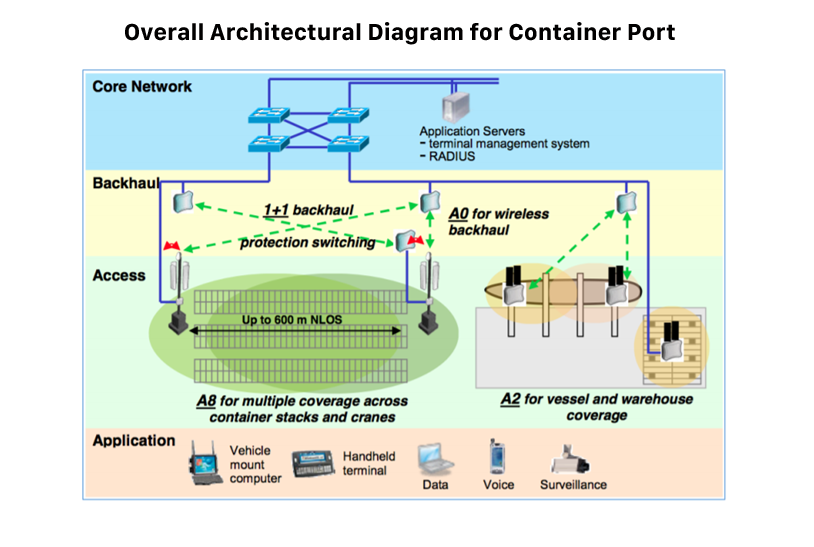Those container ports which were installed with traditional mesh AP network had experienced the following problems that could not be totally overcome:
With years of experience in using wireless network, IT administrators of container terminals now have more expectation on the performance and features of WiFi equipment:
With special care for the container port vertical market, Altai can fully comply with and exceed all the expectations mentioned above.

Altai A8 WiFi Cellular Base Station will be used for primary coverage. Double coverage will be designed in a way that for each coverage point, a user underneath can detect WiFi signal from at least 2 base stations.
Altai WiFi system provides all necessary security features including WPA and WPA2-PSK, 802.1x (PEAP, TLS, TTLS) authentication, MAC address filtering, WEP, TKIP and AES encryption, SSID disable, intra-VAP traffic blocking, captive portal for guess access and physical security. Additional Service WI-FI NETWORK SOLUTION FOR CONTAINER PORT PAGE 10/12 Controller can be used for per user, base station or SSID bandwidth control and login password authentication. Optional Intrusion Detection and Prevention System can be used for further prevention of cracking and other malicious threats.
Altai A2 WiFi Pico Access Point provides a low cost alternative for filling coverage holes. It gets 802.11a backhaul from nearby A8 using its built-in flat panel antenna and by extending to 802.11b/g for small areas. A2 is also very useful for large open indoor areas coverage such as warehouses.
Altai WiFi Management System (AWMS) will be used for full configuration, fault, security, performance, wireless link and client management with multiple languages, GUI and GPS network map support.
Altai A0 WiFi Bridge, to be installed near wire termination point, provides flexible wireless backhaul connection to A8 built-in 5 GHz 802.11a radio, if fibre connection is not available at that site. An external Ethernet WI-FI NETWORK SOLUTION FOR CONTAINER PORT PAGE 9/12 switch may be required if multiple backhauls are required. Furthermore, A0 can be used to provide backup backhaul to A8, by connecting to the Ethernet port of A8.
Altai C1 WiFi CPE will be installed at inner window sides of buildings to extend outdoor 802.11b/g signal from A8 to 802.11b/g indoor, as shown in figure 9. Alternatively, A2 can be used for large open indoor coverage.
By using multiple radio and multiple smart antenna technology, extra antenna array gain, diversity gain and special gain from signal processing technique can be attained. A 3X increase in distance or 7X increase in area coverage can be achieved. Yet, the transmit power is relatively low (default 21 dBm) to match with the low powered CPE such as PDA and SIP phone in the uplink. The symmetrical up and downlink design is essential for good voice quality in VoIP application.
By using patented Adaptive Interference Control and special signal sampling technique, A8 can operate in a signal environment with much interference and can co-exist with nearband radio equipment such as GSM and CDMA.
the AWMS will not only provide performance and fault monitoring on the network, but it also provides a lot of statistical information on Mobile Client Management including MAC address, user name, IP address, association time, signal strength, noise floor and SNR in appropriate tabular or graphical format. Administrators can even search associated clients by name, MAC address or IP address and to locate the base station that a client is associated to. Multiple simultaneous login sessions of a single user are allowed, enabling administrators to access AWMS from different computers and locations at the same time. Upgrade version of AWMS is required. Coverage estimation tool and survey tool will also be available in the future.
By using cellular backhaul architecture similar to those of GSM or CDMA base stations, dedicated backhaul of 20 Mbps can be assigned to each A8, ensuring the highest bandwidth possible for each user. A cluster bandwidth of as high as 80 Mbps can be provided. Unlike traditional dual radio mesh AP whose throughput degrades substantially as the number of hops increases to an average access throughput of only 3 Mbps per AP to users, Altai can allow each of its base stations to offer full 20 Mbps access throughput to users without the need of hopping in normal case.
Each of the 4 sector antennas can be installed at different positions horizontally or vertically, and each of which can be adjusted in orientation and down-tilted angle allowing different target distances and cell shapes. All antennas are installed for 180 degree coverage, as shown in figure 10. Antennas with different installation heights and down-tilts are shown in figure 11. This is particularly useful in a complex container port environment. The powerful coverage capability can greatly reduce the number of mounting locations, which is a scarce but expensive resource.
with much lower number of AP per area, Altai WiFi networking products can save your costs not only in hardware, but also in site buildup, installation, maintenance and operation, resulting in savings in total cost of ownership of as high as 65%! Increase in productivity and time efficiency can be realized as another form of cost-saving as well.

